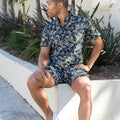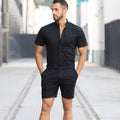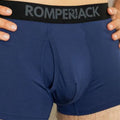How should a suit jacket fit? The difference between looking sharp and appearing disheveled often comes down to one crucial factor: fit. A perfectly tailored suit can make a powerful statement, while an ill-fitting one can easily break your entire look.
Sure, we often get caught up in fabric quality or designer labels, but here's the truth—fit trumps everything. A well-fitted suit enhances your natural body proportions, elongates your figure, and sharpens your outline. Whether you're heading to a business meeting or special occasion, proper fit gives off an air of confidence. You're not constantly adjusting your collar or tugging at your sleeves.
Most guys don't realize that almost no one has what would be considered an 'off-the-rack' body type. That's exactly why understanding how a suit should fit becomes essential for every man's wardrobe. Take the shoulder area, for instance—it's the most difficult and expensive part to tailor. You simply can't fix poor shoulder fit without full reconstruction, making it a must-get-right detail.
Ready to master the art of suit jacket fitting? We'll walk through each aspect of suit jacket fitting—from shoulders and collar to sleeves and length. By the end, you'll know exactly what to look for when purchasing your next suit and how to communicate effectively with your tailor.
1. Why Jacket Fit Matters More Than You Think
Look around at men wearing suits and you'll notice something striking—99% have jackets that fit poorly or terribly. Even when someone believes they've found a suit that "fits like a glove," their standards often aren't high enough. The truth about suit jackets goes much deeper than most realize.
Fit vs. Fabric: What really makes the difference
Many suit discussions center around fabrics, patterns, and brand names. However, these elements are secondary to the most crucial aspect—fit! Simply put, the finest fabric in the world on an off-the-rack suit will never look as good as decent fabric on a properly fitted one.
A well-fitting suit should feel almost as comfortable as wearing a sweater and sweatpants. This comfort isn't just physical—it changes how you present yourself to others. Although both fabric quality and fit matter, fit is immediately noticeable and makes a more significant visual impact.
When selecting a suit, prioritize finding a model that fits your body properly and requires minimal alterations. Once the fit is correct, other considerations like fabric, style, and durability can follow. This hierarchy of importance is something master tailors have understood for generations.
How a well-fitted jacket boosts confidence
Beyond looks, a properly fitted jacket creates a powerful psychological effect. A well-fitted suit enhances your natural physique—it hides asymmetrical features while highlighting your shoulders and chest, creating a flattering V-shape that's universally appealing.
This subtle enhancement influences not just how others see you, but how you see yourself! When your jacket fits correctly, you naturally stand taller, move more confidently, and speak with greater authority. This extra confidence can help you land jobs, close deals, or command respect in professional settings.
The change extends beyond appearance, directly impacting self-perception and performance. Unlike ill-fitting suits that require constant adjustment, a perfectly tailored jacket moves effortlessly with you, allowing you to focus on the task at hand rather than your clothing.
Common signs your jacket doesn't fit
Recognizing poor fit requires knowing specific indicators to watch for:
Shoulder issues: Perhaps the most telling sign is shoulder fit. If you see dents or divots right beneath the shoulder padding where it meets your arm, the jacket doesn't fit properly. This is also the most difficult and expensive area to alter.
Wrinkle patterns: Different wrinkles indicate different fit problems:
· X-shaped wrinkles at the button point mean the jacket is too tight
· Vertical wrinkles on the chest indicate the jacket is too large
· Wrinkles along the sleeves while arms are at rest suggest incorrect sleeve pitch
Collar and lapel problems: The jacket collar should sit close to your shirt collar. If it stands away from your neck, the jacket is likely too small or poorly made. Additionally, lapels should lie flat against the chest—if they bow outward, the jacket is too tight or incorrectly tailored.
Button strain: When a suit jacket pulls at the button, it creates unsightly X-wrinkles across the front, signaling the jacket is too tight in the chest or waist.
Spotting these signs can save you from investing in a suit that will never look truly polished, regardless of its price tag or designer label.
2. Shoulder and Collar: The Foundation of Fit
The shoulders and collar form the cornerstone of any well-fitted suit jacket. These areas create the first visual impression and essentially dictate how the rest of your jacket drapes. Getting these elements right makes all the difference between looking polished or perpetually uncomfortable.
How should a suit jacket fit at the shoulders?
A perfectly fitted shoulder lies completely flat. The shoulder seam should precisely follow your natural shoulder line and end exactly where your arm begins. This seam must be the same length as the bone beneath it, creating a clean line with no distortions.
When examining shoulder fit, look for these telltale signs:
Check for overhang first – the jacket's shoulder should rest snugly along your natural shoulder with the seam ending right at the edge. Next, watch out for ripple effects or divots. These unwanted wrinkles appear when the shoulder fit is off, creating visible lumps on the sleeve or top of the jacket.
You'll also want to be aware of two common issues: shoulder sag and shoulder bite. Shoulder sag occurs when the jacket is too large, causing the seam to fall below your natural shoulder line. Shoulder bite happens when the shoulders are too tight, creating a divot on the arm toward the back of the sleeve head.
Remember, if you're seeing any of these issues, don't try to convince yourself they're minor details. Shoulder fit can make or break your entire look.
Avoiding collar gaps and rolls
The dreaded "collar gap" ranks as the #1 cardinal sin in tailored clothing. This occurs when space appears between your jacket collar and shirt collar. A properly fitted jacket collar should always hug your shirt collar without any gap.
Collar roll presents another common issue – this happens when excess fabric bunches beneath the collar. Both problems appear at the collar, but they often stem from different causes:
· Collar gaps typically occur when there's insufficient fabric in the upper back/neck area. The collar pulls away from the neck, looking "nervous and shifty"
· Collar rolls frequently affect men with square shoulders wearing jackets cut for sloping shoulders. Sometimes collar rolls result from a short neck or erect posture where extra fabric "pools" under the collar
Your jacket collar should rest naturally against your shirt collar, with neither significant pressure nor gaps between layers. Don't settle for anything less than this standard.
Why these areas are hardest to tailor
Here's something most guys don't realize: the complex structure of jacket shoulders makes them particularly challenging to alter after construction. Master tailors often describe making shoulders either bigger or smaller as "major surgery" due to their intricate construction.
Shoulder alterations can cost significantly more than other adjustments. Even when possible, they risk disrupting the jacket's entire balance and proportions. The process typically involves removing sleeves, redrawing the armscye, and reattaching sleeves – affecting sleeve length and requiring multiple fittings.
Fixing collar issues remains equally challenging. While a collar that's overly large can theoretically be removed and recut, this proves costly and complex. Collar gaps often have multiple potential causes beyond simple sizing – including asymmetrical shoulders or particular postures.
Most tailoring experts agree: these fundamental fit issues are better addressed by finding the right jacket initially rather than attempting extensive alterations afterward. For men with significantly square or sloping shoulders, custom tailoring often represents the most sensible investment.
Everything starts with the shoulders – get this right, and you're well on your way to that perfectly fitted look.
3. Chest, Lapels, and Button Stance
Once you've nailed the fit at the shoulders, it's time to focus on the chest area—where most of the visual impact happens. The chest, lapels, and button stance work together to create the defining silhouette of your jacket.
How the chest should feel when buttoned
A properly fitted jacket chest should feel snug yet comfortable. When buttoned, the fabric should drape cleanly across your torso without strain or excess material. You'll know your jacket fits correctly when:
· The front lies smooth with no visible pulling
· The fabric doesn't bunch or create "pooling" near the armholes
· The button closes easily without creating an "X" shape of wrinkles
Here's a simple test for your jacket's chest fit: place your hand flat below the buttons and make a fist—if this causes the jacket to pull excessively, it's too tight. The chest should accommodate natural movement without restriction, allowing you to reach, stretch, or embrace without awkward pulling.
Lapel alignment and shape
Lapels serve as both functional and style elements of your jacket. Properly aligned lapels should lie completely flat against your chest without gaping. Lapels that bow outward indicate insufficient room across the chest, even if the waist area seems adequately sized.
When it comes to lapel style, the most versatile option is the notch lapel—where the lapel meets the collar at an angle, creating a triangular notch. Peak lapels point toward the shoulders and make a bolder statement, often seen on formal jackets.
The width of your lapels should maintain proportion with your chest size—broader chests generally call for wider lapels. For classic versatility, aim for lapels that reach approximately halfway between the inner edge and the outer chest.
Finding the right button position
Button stance—the position of the waist button on your jacket—affects both comfort and visual proportions. The button should align with the narrowest part of your torso. For a two-button jacket, the top button should never fall below your navel.
The button stance creates different effects:
· Natural stance (at the waistline): Creates a balanced look suitable for most body types
· Lower stance: Elongates the torso—beneficial for men carrying weight in the midsection
· Higher stance: Can make legs appear longer—useful for shorter men with longer torsos
Remember, button placement isn't merely decorative—it determines how the jacket drapes and shapes your silhouette. The right stance creates harmony between your upper and lower body proportions.
4. Sleeves and Armholes: Comfort in Motion
Perfect sleeve fit goes beyond just looking good—it's all about functionality. A well-fitted jacket sleeve lets you move comfortably without sacrificing style, creating that perfect balance between sharp appearance and practical wearability.
Getting sleeve length just right
The rule for proper sleeve length is pretty straightforward: your jacket sleeve should end just above your wrist bone where your hand begins. This positioning allows approximately 1/4" to 1/2" of shirt cuff to show when your arms are relaxed at your sides. This small detail creates visual harmony between your jacket and shirt.
Too little cuff exposure makes your jacket appear oversized, while excessive cuff (anything beyond 1.25") suggests poor coordination between garments. Many tailoring experts actually recommend matching the amount of visible shirt cuff to the amount of shirt collar showing at the back of your neck for perfect proportion.
Keep in mind that your stance affects cuff visibility—when sitting, sleeves naturally reveal about 1/2" of cuff compared to 1/4" when standing. This variation should be factored into your fitting.
Why high armholes make all the difference
High armholes represent a hallmark of superior jacket construction. Unlike lower armholes (common in mass-produced suits), high armholes allow you to move your arms freely without pulling the entire jacket upward.
The benefit is remarkable: lift your arms as if placing a painting on the wall—with properly positioned armholes, your jacket stays put. This engineering detail explains why musicians, especially conductors, require high armholes for unrestricted movement.
Beyond mobility, high armholes create a more flattering silhouette by making arms appear longer. They also naturally improve posture—properly cut high armholes gently encourage upright standing.
What can be fixed through tailoring
Sleeve alterations rank among the more straightforward jacket modifications. Here's what's possible:
· Lengthening sleeves: Possible by about 0.5-0.75", limited by available fabric under the cuff
· Shortening sleeves: Generally easier, but can bring sleeve buttons uncomfortably close to the edge
· Sleeve narrowing: Achievable but limited by armhole size
For jackets with functioning buttonholes ("surgeon's cuffs"), alterations become more complex since buttonholes can't be easily covered or moved. Professional tailors might alter sleeves from the shoulder rather than the cuff—a more expensive but cleaner solution.
Spiral wrinkles in sleeves typically indicate incorrect sleeve pitch (the angle at which the sleeve connects to the armhole). This requires skilled tailoring to correct.
Remember, a great sleeve fit should feel natural and allow you to move confidently throughout your day!
5. Waist and Jacket Length: Shaping the Silhouette
The final pieces of the puzzle involve your waist and overall jacket length—elements that define your entire silhouette and bring everything together.
Creating a natural taper at the waist
A well-fitted jacket should taper slightly at the waist, creating a subtle "V" shape that defines your masculine frame. This contouring brings the garment closer to your body, creating a leaner silhouette without compromising comfort. For athletic builds, proper waist fit enhances that chest-to-waist ratio, while for broader waistlines, a slight taper provides form without emphasizing the midsection.
Here's a simple test for proper waist fit: use the "three-finger rule"—you should be able to comfortably place three fingers inside the jacket when buttoned. Anything tighter causes pulling, while anything looser creates an unflattering boxy shape.
Tailors recognize three standard fit styles to choose from:
· Slim fit: Higher tapering at the midsection (not just tight)
· Tailored fit: The mid-range option preferred by most guys
· Classic fit: Minimal tapering with greater comfort and movement
How long should a suit jacket be?
Jacket length follows a traditional rule: it should cover your seat completely. The professional standard places the hem around your mid-crotch area. For precise measurement, let your arms hang naturally—the bottom edge should align with the middle of your thumb knuckle.
Another technical method measures the jacket at approximately half the distance between your neck base and the ground.
Today's trends offer options beyond traditional rules:
· Classic length: Ending around the end of your thumb
· Mid-length: Ending at the middle thumb knuckle (most versatile)
· Contemporary: Slightly above the seat (more fashion-forward)
Balancing proportions for different heights
Body type dramatically affects ideal jacket proportions, and getting this right can make a huge difference in how you look.
For shorter guys, a slightly shorter jacket (ending just above the seat) helps elongate the legs and creates the impression of height. Avoid jackets that extend too long, as they make you appear smaller.
For taller men, traditional-length jackets that fully cover the seat help create balance. A jacket that's too short can make legs appear unnaturally long.
Men with long legs but short torsos benefit from slightly longer jackets to create upper-lower body balance. Those with long torsos and shorter legs should consider shorter jackets that create the illusion of longer legs.
Remember, these proportions work together to create your overall silhouette, so don't be afraid to experiment with different lengths to find what works best for your body type!
Conclusion
Understanding how a suit jacket should fit changes everything—not just your appearance but your entire presence. Throughout this guide, we've covered the crucial elements that make a jacket truly yours rather than simply something you wear.
Remember, shoulders and collar create the foundation of your jacket. These areas prove most challenging to alter, so getting them right from the start saves both frustration and expense. A perfectly fitted shoulder lies flat with no divots or overhang, while your collar should hug your shirt without gaps.
Your chest, lapels, and button stance work together to create your jacket's visual impact. Your jacket should feel snug yet comfortable when buttoned, with lapels that lie completely flat against your chest. The button position, ideally at your natural waistline, determines how your jacket drapes and shapes your silhouette.
Sleeves and armholes significantly affect both comfort and mobility. Well-fitted sleeves end just above your wrist bone, showing approximately 1/4" to 1/2" of shirt cuff. High armholes, though less common in mass-produced suits, allow remarkable freedom of movement without disrupting your jacket's position.
Finally, proper waist tapering and jacket length complete your silhouette. A slight taper creates that subtle "V" shape defining your frame, while traditional length covers your seat completely. Contemporary options offer variations based on your height and proportions.
Here's the truth: the difference between an average suit and an exceptional one rarely lies in brand names or price tags. It comes down to fit. Even an inexpensive jacket that fits perfectly will outshine a designer piece that hangs poorly on your frame. Developing a relationship with a skilled tailor might be your most valuable fashion investment.
Next time you put on your jacket, check these key elements. Should you notice issues with fit, you now have the knowledge to address them effectively. Remember, confidence is key when wearing a suit, so wear it with pride and own your style!
Don't be afraid to invest time in finding the right fit—it's worth every effort. After all, wearing a properly fitted suit jacket doesn't just improve your appearance; it enhances your confidence, posture, and presence wherever you go.







